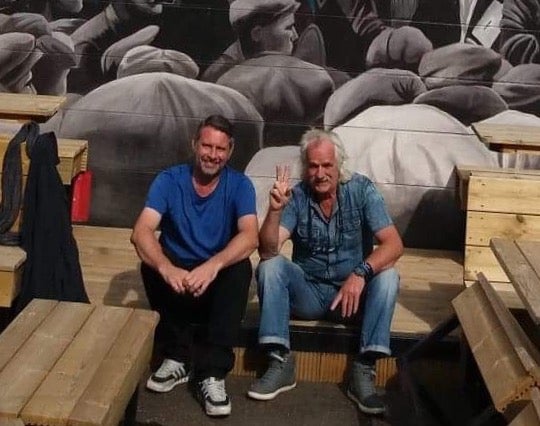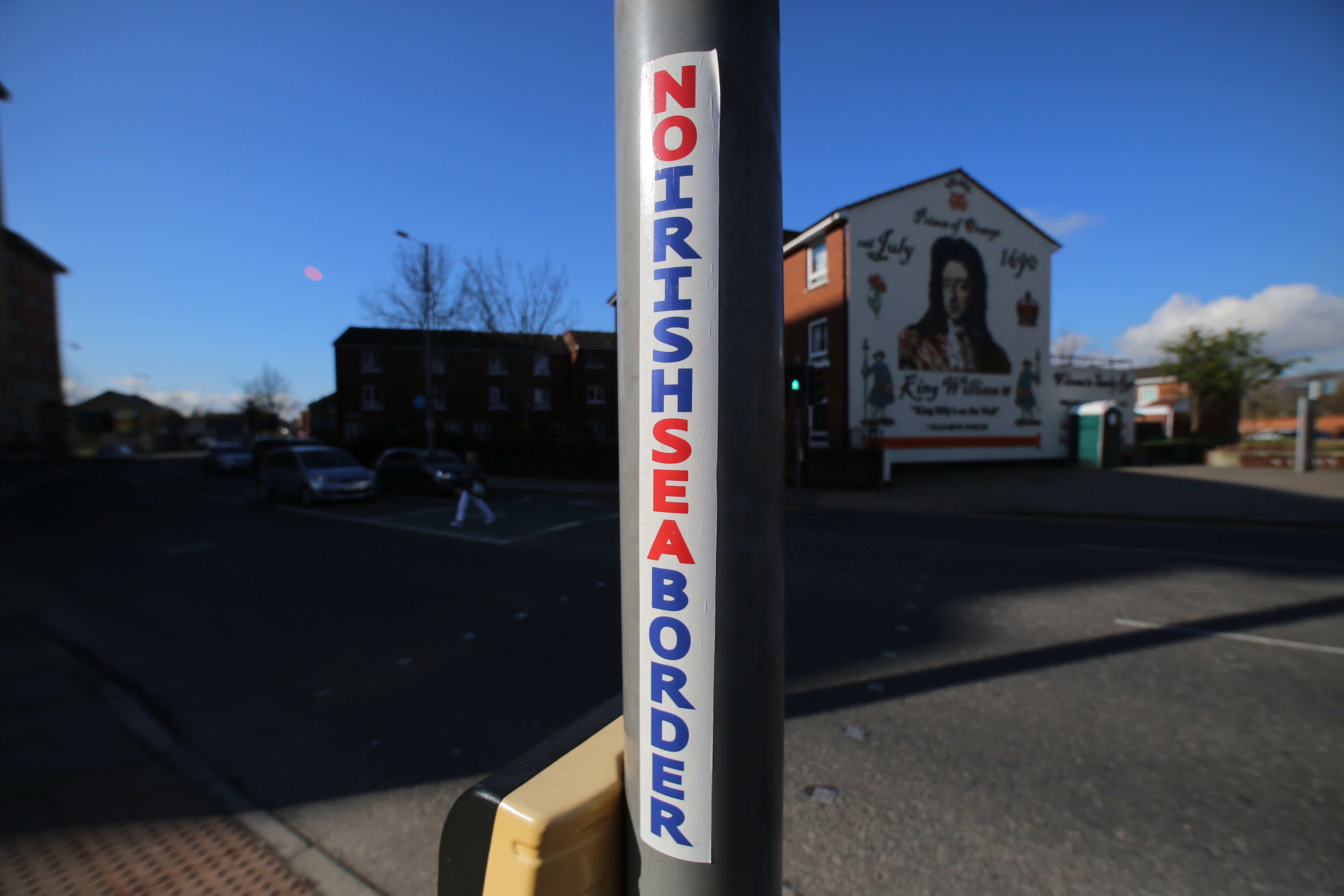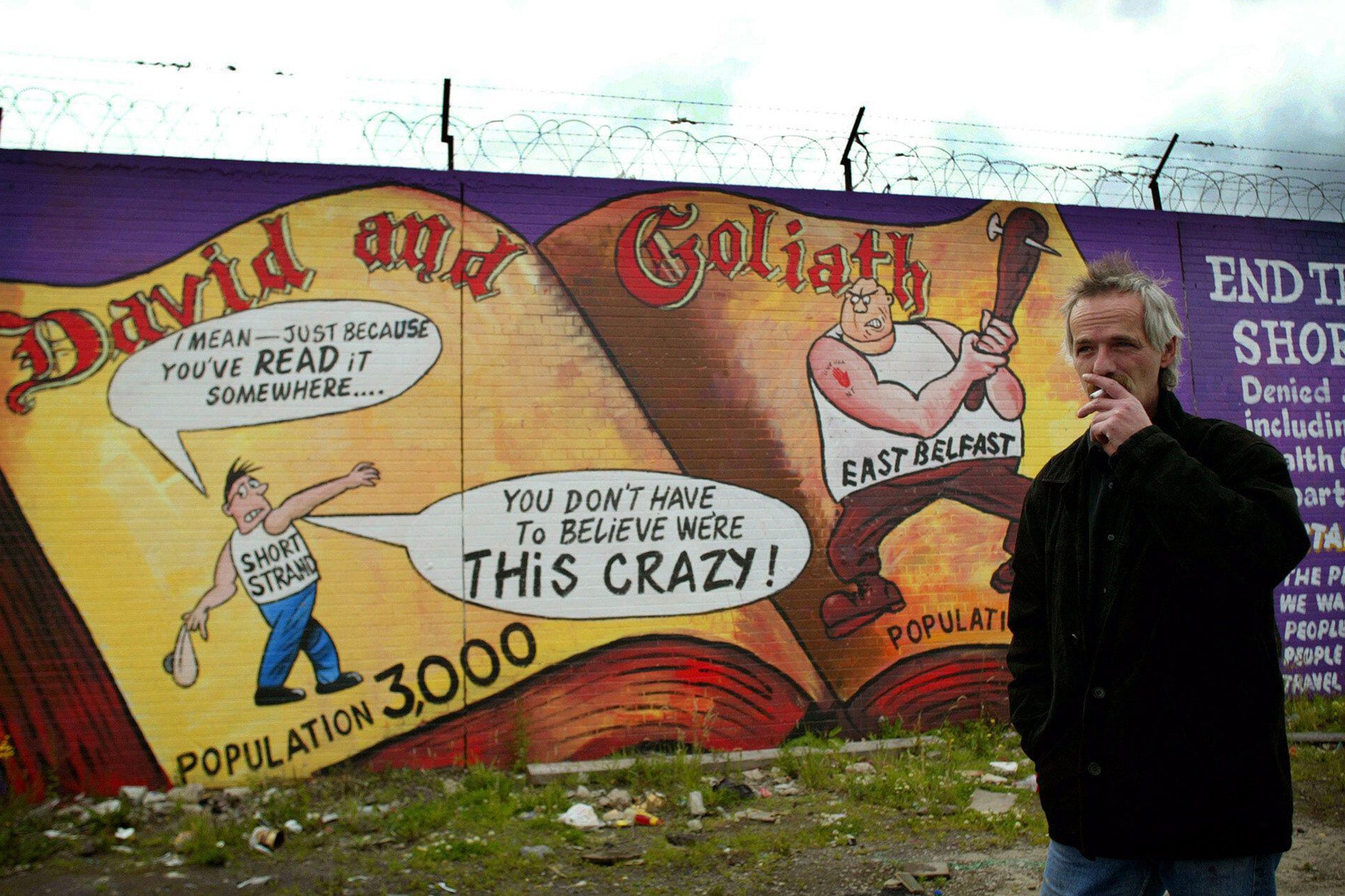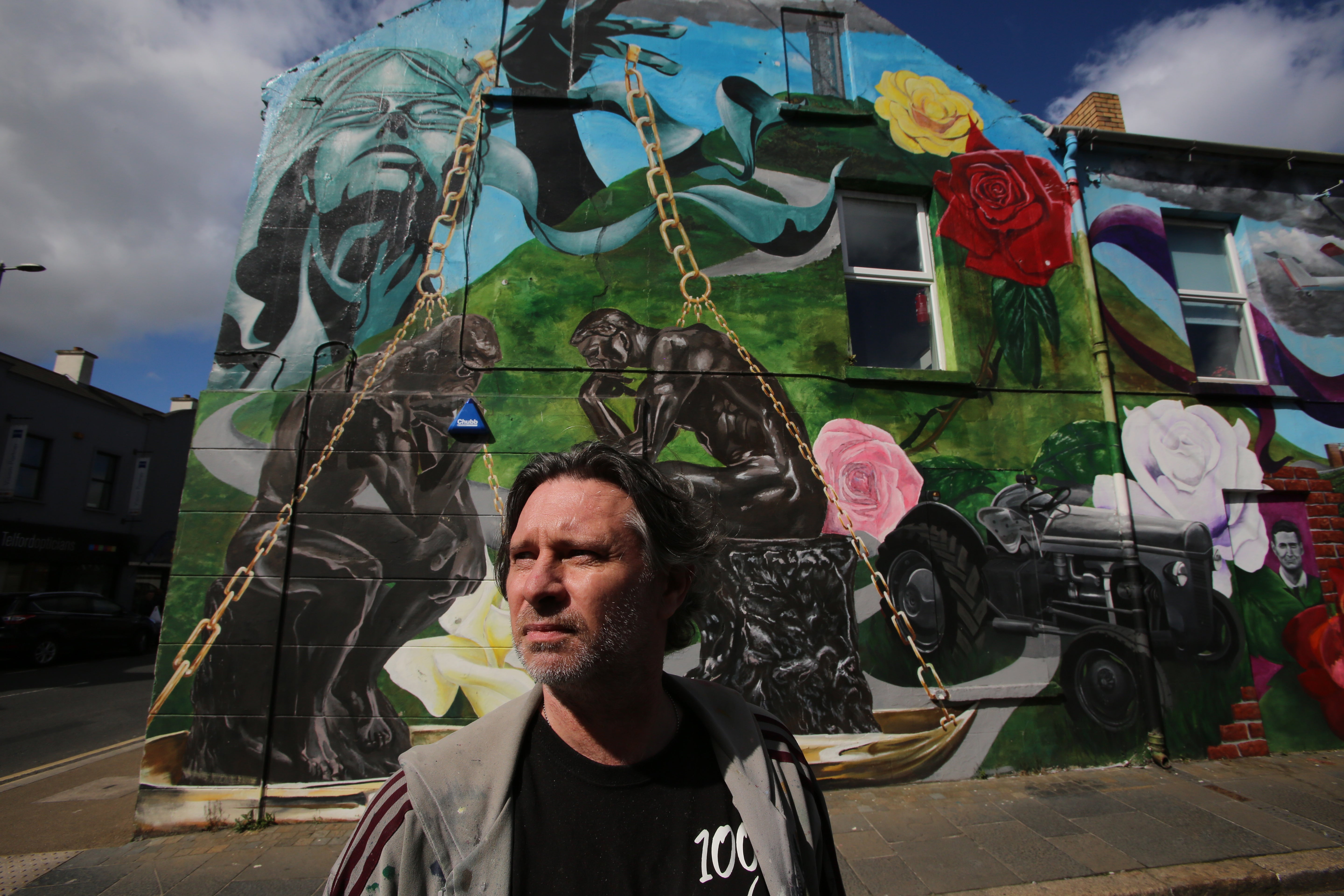Belfast’s murals brought them together – now their communities could be divided once again
Mark Ervine and Danny Devenny grew up close to one another, but the Troubles kept them apart. They united to produce some of Belfast’s stunning murals, but with tensions flaring once again, they explain why it’s essential to look beyond the politics of the past
Your support helps us to tell the story
From reproductive rights to climate change to Big Tech, The Independent is on the ground when the story is developing. Whether it's investigating the financials of Elon Musk's pro-Trump PAC or producing our latest documentary, 'The A Word', which shines a light on the American women fighting for reproductive rights, we know how important it is to parse out the facts from the messaging.
At such a critical moment in US history, we need reporters on the ground. Your donation allows us to keep sending journalists to speak to both sides of the story.
The Independent is trusted by Americans across the entire political spectrum. And unlike many other quality news outlets, we choose not to lock Americans out of our reporting and analysis with paywalls. We believe quality journalism should be available to everyone, paid for by those who can afford it.
Your support makes all the difference.Walking along Belfast’s peace lines, Mark Ervine came to a sudden halt, pointed to the wall and warned: “It should be clear that we are now going into enemy territory; it’s dangerous for me, so there’s a need to be very careful”.
The “frontier” between Britain and Ireland was demarcated by the change in the row after row of murals, the intrinsic art form which has charted Northern Ireland’s turbulent politics. The paintings, graphic, often beautiful, portray loyalty and faith, solidarity and revolution, and also acts of violence, death and grief.
Ervine, the son of a famous loyalist paramilitary leader, was pointing out that he was putting himself at risk by walking towards the nationalist Falls Road. He was, however, speaking mostly in jest. One of the first murals in the “hostile” republican side was by him drawn with Danny Devenny, a former IRA member who had been jailed during the Troubles.
The two men had first collaborated 14 years earlier, producing a local recreation of Guernica, Picasso’s poignant masterpiece which is regarded as one of the most powerful cries against the sorrow and pity of war.
David Ervine, Mark’s late father, was an active member of the Ulster Volunteer Force (UVF) who was found guilty on charges of possessing explosives and endangering life. While in prison he and other hitherto hardline loyalist inmates like Gusty Spence and Billy Hutchison decided to put down the gun and turn to negotiations and politics. They, alongside Republican paramilitaries who had also taken that path, played a vital part in developing the peace talks which eventually led to the historic Good Friday Agreement, ending 30 years of bombings, shootings and 3,700 deaths.
But the shadow of sectarian strife is looming once again. In the nights leading up to last weekend’s anniversary of the agreement, riots broke out in Belfast and elsewhere with petrol bombs thrown and buses set alight. The police used water cannons and rubber bullets: 88 officers were injured.

The clashes had started in loyalist areas, the result, say community leaders, of anger and frustration. The protestants feel they are being cut adrift by the Westminster government and that their British identity is being eroded. There is also anger at the decision by Northern Ireland’s Public Prosecution Service not to bring any charges against 24 Sinn Fein politicians, including the deputy first minister, Michelle O’Neill, who attended the funeral of Bobby Storey, a senior figure in the Republican movement, over an alleged breach of coronavirus guidelines.
The establishment of a sea border under the Northern Ireland protocol following Brexit has added to the sense of alienation and uncertainty. The situation is likely to get worse, leaders have warned, with the marching season – which has seen violence in the past – fast approaching.

Murals have recently gone up in unionist areas bearing messages saying “No Irish Sea Border”, “Loyalist Village Says No To Irish Sea Border” and “You Cannot Divide the United Kingdom” along with the traditional ones of paramilitaries, pledging allegiance to the crown and the union, and ones of heritage about William of Orange and the Battle of the Boyne.
The loyalist community is missing unity and direction, according to some observers and analysts. It has “lacked a political voice since the death of the charismatic leader David Ervine”, wrote Jonathan Powell, who was the chief British negotiator in Northern Ireland under Tony Blair, in a newspaper article this week.
“My father would be very saddened by what is going on at the moment. So much effort had gone into bringing about reconciliation between the communities to try and have a normal society, and now we are seeing something very worrying,” said Mark Ervine.
“People have causes to be angry. But it will be a huge backward step if the communities begin to turn on each other. So much time has been wasted by these divisions. Just a personal example – Danny Devenny and I grew up not that far from each other, we obviously have the same interest in art, in murals, in social issues. But the Troubles kept people like us apart from each other.”

Ervine and Devenny have become known internationally for their work. They had both painted murals abroad, their trips bringing them into contact with the glitterati as well as politicians, academics and the media. Ervine is due to work in Chile, the US and England, among other places, when Covid travel restrictions are eased.
Devenny went to a grammar school and would probably have gone to an art college, he says. But the Troubles began and he joined the IRA as a teenager. He was sentenced to three years in prison in 1973 for his part in robbing a bank to raise funds for the cause. At Long Kesh, where paramilitary prisoners from both sides were held, and where David Ervine began his political education, Devenny’s fellow inmates included those who would become the leading figures in the republican movement like Gerry Adams and Danny Morrison.
People have causes to be angry, but it will be a huge backward step if the communities begin to turn on each other. So much time has been wasted by these divisions
Devenny’s life in the arts began in prison with drawings to illustrate a political column by Adams for An Phoblacht (Republican News). He got a job with the paper when he was released, but the entire editorial team was arrested by the authorities soon afterward the News got shut down.
Devenny went to Dublin to help set up a printing operation for Sinn Fein. While there he was shot by a loyalist gunman, allegedly from the Ulster Freedom Fighters. Accompanying him when the attack took place was Patrick Magee, who was to be later convicted for attempting to blow up Margaret Thatcher and her cabinet at the Conservative Party conference in Brighton.
It is a sign of the changes which have taken place since the Good Friday Agreement that Devenny painted the official portrait of the lord mayor of Belfast which hangs at City Hall, an edifice of Victorian certainty and Protestant Ascendancy. It is also a sign of changing times that the lord mayor was Niall O Donnghaile, of Sinn Fein.
Is there a danger of the clock being turned back? Talking about the loyalist protests, Devenny says that “these people need to make up their minds who they are really angry with, is it the British government, the DUP (Democratic Unionist Party, part of the Northern Ireland Executive), is it the police, is it Sinn Fein?
“They should be questioning in whose interest it is to stir up violence. You have the DUP putting blame on the Shinners [Sinn Fein] and then you get petrol bombs being thrown over the Peace Wall on Lanark Way.
“Whose interests are they really serving, the interest of the DUP? People in the British State whose interest it is to divide communities here? They have done that before, why shouldn’t they do it now?”

Ervine and Devenny’s meetings have been infrequent during the pandemic lockdown. Devenny was also unwell for a period.
“We still see each other from time to time, we argue about politics, not just in Northern Ireland,” said Ervine. “There is a definite feeling in the loyalist community that they have been hard done by. They feel they are under siege, culturally if not physically, they are very worried about the future. But the rioting was wrong, they are just destroying things on their own doorstep.”
Ervine agrees with Devenny that the community needs to look at where blame lies. “The DUP have been using the protestant people for their own agenda and Boris Johnson’s government in London don’t see beyond London, they don’t care about what’s happening in Northern Ireland”, he says.
“The politicians in the UK and the EU between them are threatening to do what the IRA tried and failed to do with 40 years of bombing – divide the country. It’s up to us to look beyond the politics of the past.”
Walking down Northumberland Road along the peace lines Ervine pointed to the differences, which still remain, between loyalist and republican murals. The former are about British identity, Queen and country, service in Britain’s wars. The latter have paintings of Irish nationalism, but they are more international in scope, commemorating the anti-apartheid movement, the victims of military dictatorships, the fight against colonialism.
“The unionists need to reassure themselves about their identity, who they are because they are under threat, I suppose,” said Ervine. “But that is changing, there are some more outward looking ones, that will happen more and more hopefully if we don’t slip back to the past.”
There are, in fact, other issues on display in the murals, about the climate change emergency, women’s rights, mental and emotional stress, modern music and culture.

Some commercial concerns are also keen to keep with the mural heritage. The current painting Ervine is working on is at the offices of Russell + co, a firm of solicitors.
As well as the scales of justice, they show images of the local community. Colin Haddick, the practice’s principal, and a member of the Law Society Council, said: “This seemed the ideal way to use a plain wall. Murals are something which has become the part of culture here.”
Mr Haddick is involved in charitable work with colleagues in Ireland, with meetings often taking place in Dublin. “We can’t travel there now because of Covid, the restrictions are understandable but feel odd because we were so used to free movement,” he said.
“The idea of a border seems so strange. We will have to see how the political process works out. Businesses, including us, have got through the pandemic alright so far, but this outbreak of violence is a matter of concern. Will people want to come to Northern Ireland, to invest here, after seeing these scenes? We have come through worse violence in the past, but this is quite worrying for us all.”


Join our commenting forum
Join thought-provoking conversations, follow other Independent readers and see their replies
Comments